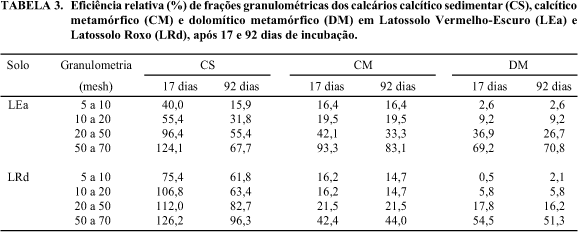In Mato Grosso do Sul, Brazil, there are limestone mines formed from sedimentary rocks, which have higher initial reactivity than that of metamorphic rock limestones. At Embrapa-Centro de Pesquisa Agropecuária do Oeste (CPAO), Dourados, Mato Grosso do Sul State, Brazil, the relative efficiency of limestone granularity fractions were evaluated under greenhouse conditions, using Dark-Red Latosol and Dusky-Red Latosol soils, both Oxisols. Each soil was amended with a dosage of lime high enough to elevate the pH (CaCl2) to 6.0. The treatments, at a completely randomized experimental design, were a control (without lime) and four granularity fractions: 4.00 to 2.00 mm; 2.00 to 0.84 mm; 0.84 to 0.30 mm; and 0.30 to 0.21 mm. Three limes were tested: calcitic of sedimentary origin (CS) and calcitic (CM) and dolomitic (DM) of metamorphic origin. No differences were observed on the effectiveness of the limes of the same origin in increasing the soil pH level. The relative efficiency of the different limes was influenced by the geologic origin, the granularity, the soil type, and the incubation period. The initial CS relative efficiency was higher than the ones from metamorphic origin, and was higher or at least equal up to three months of incubation.
reactivity; incubation; soil pH; parent material; sedimentary rocks; metamorphic rocks; particle size





